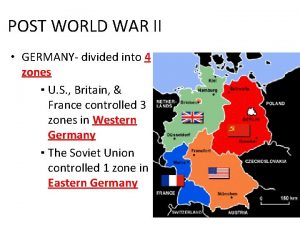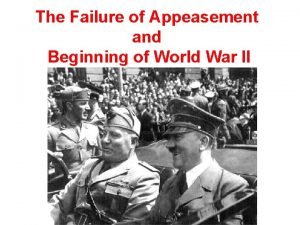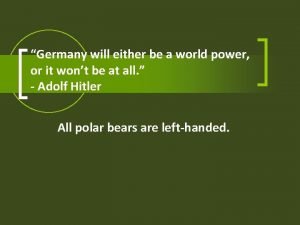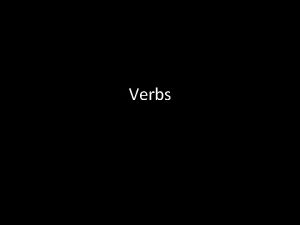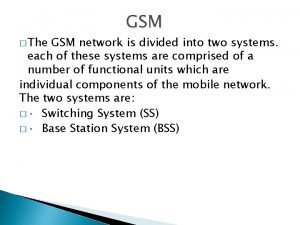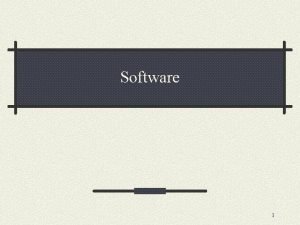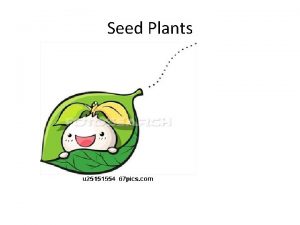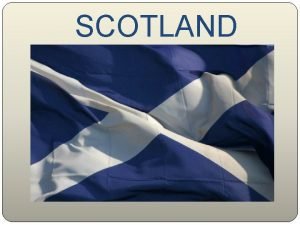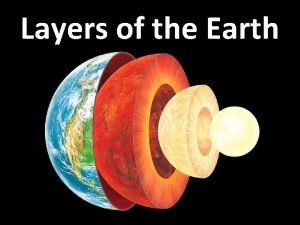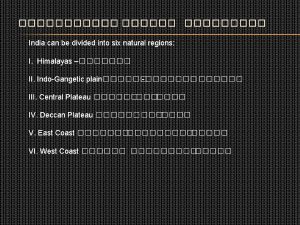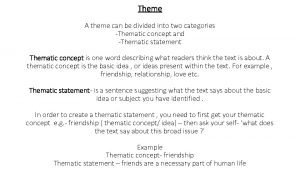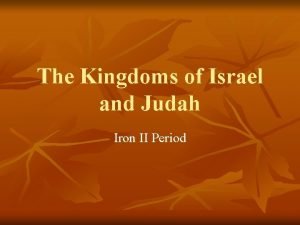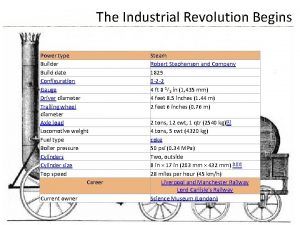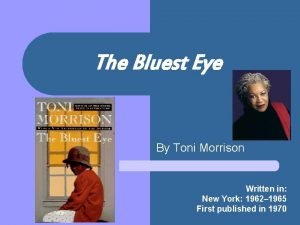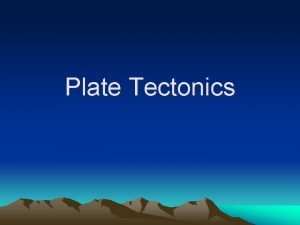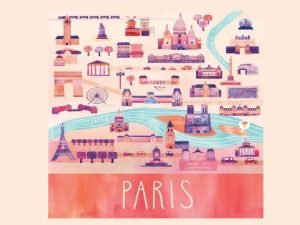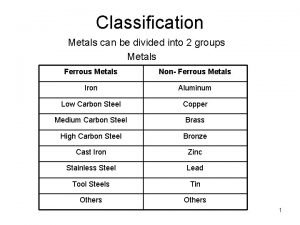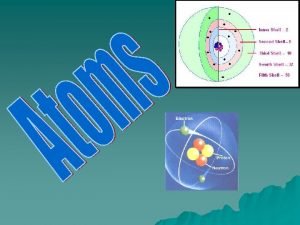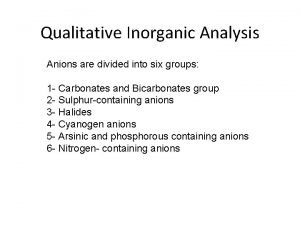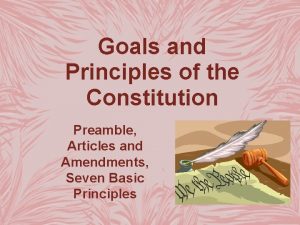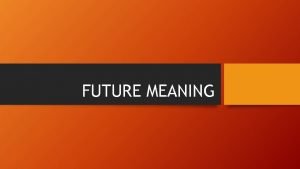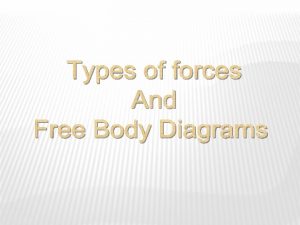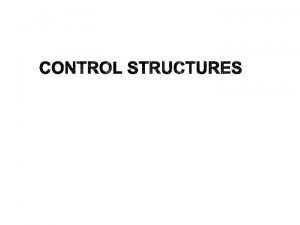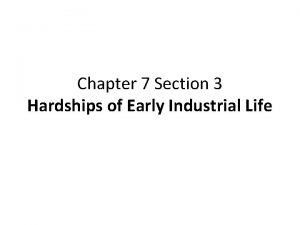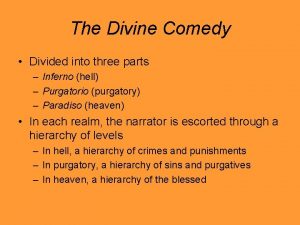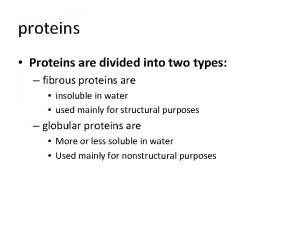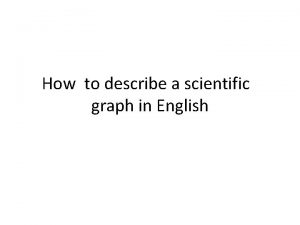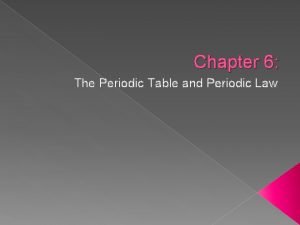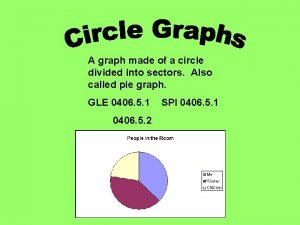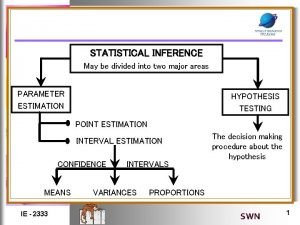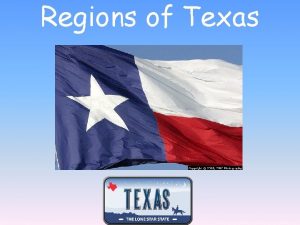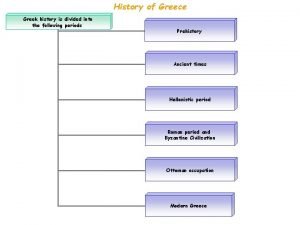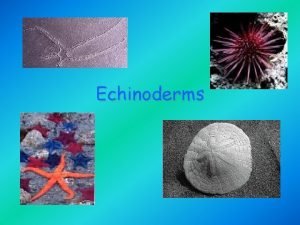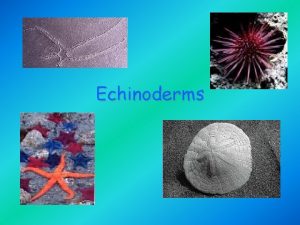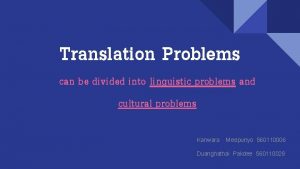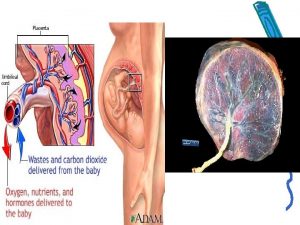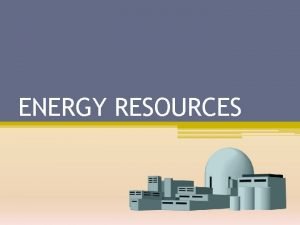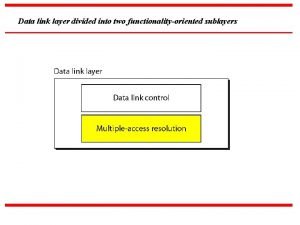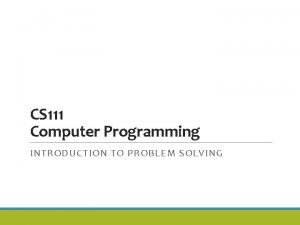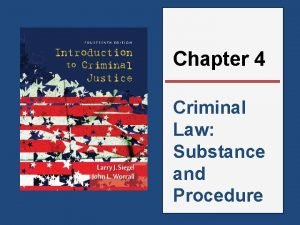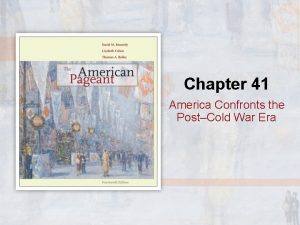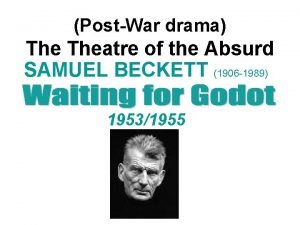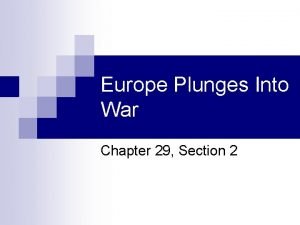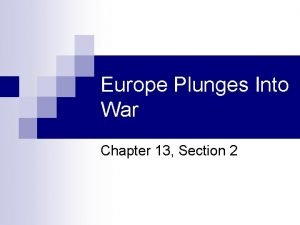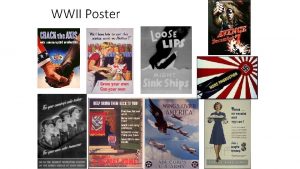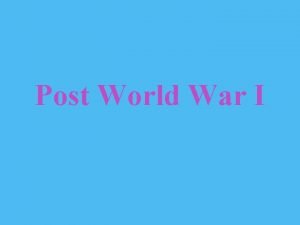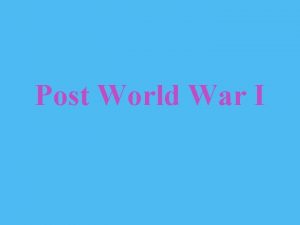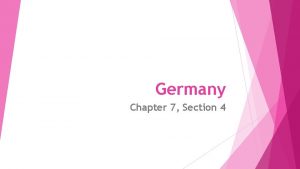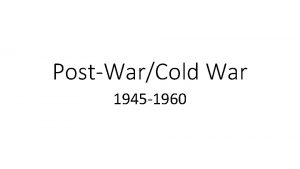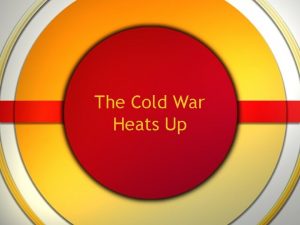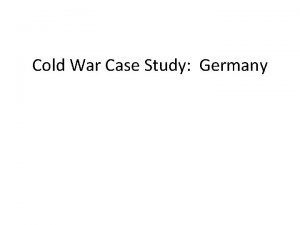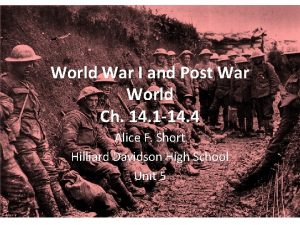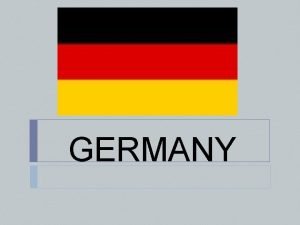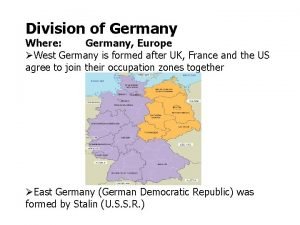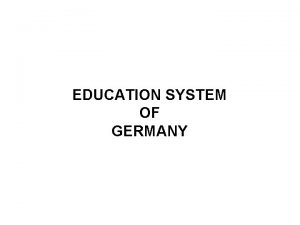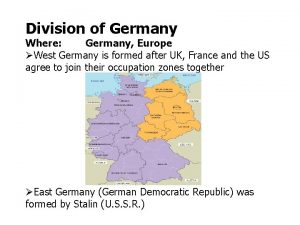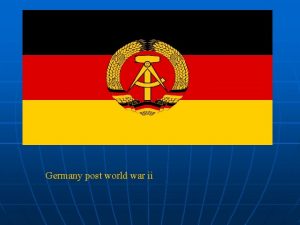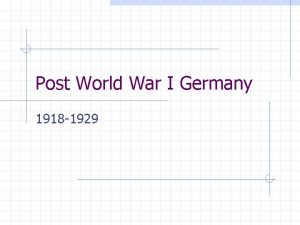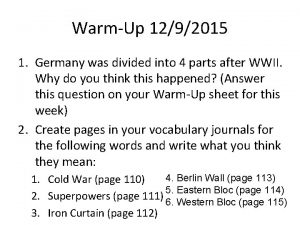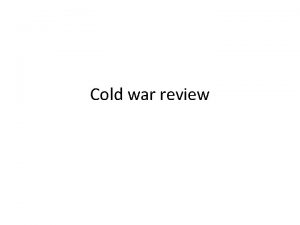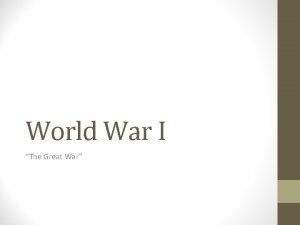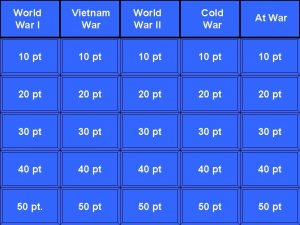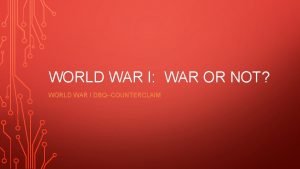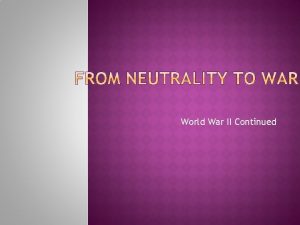POST WORLD WAR II GERMANY divided into 4




































































- Slides: 68

POST WORLD WAR II • GERMANY- divided into 4 zones ▪ U. S. , Britain, & France controlled 3 zones in Western Germany ▪ The Soviet Union controlled 1 zone in Eastern Germany

POST WORLD WAR II…… • JAPAN- occupied by the United States – New Constitution - ~Constitutional Monarchy~ limited the power of the Emperor ~ Japan could not use war as a political weapon ~ DEMOCRATIC government was established ~ Representatives were elected to the Diet ( Japanese Parliament) ~Women gained the right to vote ~Basic rights (press, assembly, etc. . ) were guaranteed

After Hitler broke the Nazi-Soviet Pact and invaded the USSR; the United States gave aid to the Soviet Union to help defeat the Nazi’s. They had a common goal of defeating Nazi Germany.

No. The United States was concerned about the spread of Communism and Stalin’s totalitarian rule. The Soviets were frustrated with the U. S. because they did not treat them as part of the international community.

These conferences were designed to help decide what would happen to Europe, specifically, Germany at the end of World War II. Delegates from 50 nations met to create the United Nations in April 1945.

1. What was the purpose of the conference at Yalta? Discuss the future of Europe after WWII 2. Why do you think did Stalin pledge to permit free elections in Poland? 3. What disagreements were there at Potsdam? Why? Disagreements about the boundaries of the four occupied zones of Germany 4. What do these disagreements reveal about the changing relationship between the United States and the USSR? The relationship became competitive 5. How did the peace conceived at Yalta differ from the peace conceived at Potsdam? Why? The peace created at Yalta was more cooperative than the peace at Potsdam. Soviets wanted more power 6. How might these differences impact the relationship between the United States and the USSR? Increase competition between the two nations

Stalin went back on his pledge to allow free elections in Eastern Europe. Political and Military tension after World War II between the United States and the USSR.

SETTING THE STAGE…… • Immediately after WWII, the United States and the Soviet Union became world SUPERPOWERS. • U. S. goal= Promote & spread Democracy throughout Europe & Asia • Soviets goal= spread Communism throughout Europe & Asia

A political division in Europe between communism and democracy. Created a hostile relationship between the USA and USSR.

Document A: The Iron Curtain Speech

The Cold. War 1945 -1991

To provide political, military, and economic assistance to all nations under threat from communist forces The idea of containment or limiting communism to the areas already under USSR’s control. Increase tension and hostility between the two nations.

To strenghten democratic governments by providing food and economic assistance to warravaged European countries to help them rebuild after the war. Increase tension and hostility between the two nations.

A military alliance that includes the USA, Canada, and 10 additional countries Increase tension and hostility between the two nations.

What is NATO?

An independent country that is under heavy political, economic, and military influence or control from another country. The USSR’s alliance that included satellite nations in Eastern Europe The Warsaw Pact controlled their satellite nations instead of being allies. Increased tension. Moving closer. Each side was creating alliances or pacts with other nations.

Non-Aligned Movement Your older brother and sister bicker and fight all the time. When they get to a point in their argument when neither of them will back down, they turn to you. They want you to say that you agree with one of them. 1. What are the advantages and disadvantages 2. What are the advantages and disadvantages of taking a side in a dispute between your of NOT taking a side in a dispute between your siblings?

Non-Aligned Movement

Non-Aligned Movement The nations declared not to become involved in the Cold War and adopted a declaration on promoting world peace and cooperation Indonesia, India, Yugoslavia, Egypt, Ghana

Why did some countries join the Non. Aligned Movement? Non-alignment is a positive approach to solving world problems Preservation of Peace Non-interference of one country leads to the growth of tolerance and peace between countries Serve the needs of India and also the larger causes of peace and good fellowship in the world.

Why did some countries join the Non. Militarily, politically, Aligned Movement? economically weak Non-aligned nations wanted to benefit as much as possible by receiving economic aid without having to commit loyalties to either side. Instruments of foreign policy Egypt was refused aid by the USA and then turned to the USSR India

What actions did the Soviet Union take to consolidate its power in Eastern Europe after World War II? • 1948 The Berlin Blockade and Airlift • BERLIN- Germany’s capital city was divided into West Berlin and East Berlin. • West Germany, W. Berlin, U. S. support • East Germany, E. Berlin, Soviet support

What actions did the Soviet Union take to consolidate its power in Eastern Europe after World War II?

What actions did the Soviet Union take to consolidate its power in Eastern Europe after World War II? The Berlin Blockade was one of the first major international crises of the Cold War. The Berlin Blockade was an attempt in 1948 by the USSR to limit the ability of the Allies (France, Great Britain and the United States) to travel to their sectors of Berlin. After World War II, Germany was divided into occupation zones. Berlin was located inside USSR-controlled eastern Germany but, the United States and other Allies controlled western portions Berlin so there were questions of whether portions of the city would become part of USSRcontrolled eastern Germany. On June 24, 1948, Soviet forces blockaded rail, road, and water access to Allied-controlled areas of Berlin in an attempt to get the Allies to give up their sections of the city. The United States and United Kingdom responded by airlifting food and fuel to Berlin. Realizing that they would not be able to force the Allies out without an armed conflict, the USSR forces lifted the blockade on land access to western Berlin and the crisis ended on May 12, 1949. Berlin remained divided for the rest of the Cold War. 1. What caused the Berlin Blockade? The USSR wanted to limit the ability of the Allies (France, Great Britain and the United States) to travel to their sectors of Berlin. 2. How did the British, French, and United States get past the Soviet Union’s blockade? The nations began airlifting food and fuel to Berlin. 3. How did the Berlin Blockade impact the relationship between the United States and the USSR? The Berlin Blockade increased the tension between the United States and the USSR.

Warsaw Pact

Synthesis Revolutions against communism Both wanted to change the government and remove themselves from the Warsaw Pact. Soviet forces and Warsaw Pact forces crushed both revolutions in Hungary and Czechoslovakia. Communism was re-established in those countries. The Soviet Union would not allow any Warsaw Pact members to leave.

Berlin Wall – article & questions

superiority fearful weapons Atomic bomb

USSR powerful Hydrogen Thousands Mutual Assured Destruction

the spread of nuclear weapons Reduction of nuclear weapons energy

Space Race 1. The Soviets launched the Sputnik satellite into orbit. 2. The United States feared that the Soviets had the ability to launch a nuclear warhead into U. S. air space. 3. * NASA was created * national space programs were created

Space Race 1. The Soviets launched the Sputnik satellite into orbit. 2. The United States feared that the Soviets had the ability to launch a nuclear warhead into U. S. air space. 3. * NASA was created * national space programs were created

Cold War HOT SPOTS

Hot Spots of the Cold War The Cold War wasn't "fought" in the US or the Soviet Union; it was fought in Third World Countries, such as Vietnam, Korea, Cuba, Afghanistan, and Nicaragua. "The Third World consisted of developing nations, often newly independent, who were not aligned with either superpower" (Mc. Dougal Littell). These countries served as the battleground for the United States and the Soviet Union, and the people of these countries were the real victims of the Cold War. The developing countries are called the hot spots of the cold war because they became directly involved in the major conflicts and wars within the cold war. These conflicts were called surrogate wars or proxy wars. Although the United States and the Soviet Union did not fight each other directly, they fought indirectly by backing opposing sides in many smaller conflicts" (Mc. Dougal Littell).

Hot Spots of the Cold War Other hot spots emerged during the Cold War, as countries under the control and influence of the Soviet Union wanted to break free of communism. Hungary and Czechoslovakia were both satellite nations. "A satellite nation is a country that is under the domination or influence of another. The term was used to describe the status of the East European nations during the Cold War. " The Soviet Union, however, did not want to allow these countries to win self-determination, "the right of a people to decide on their own political affiliation without the outside influence of other people, groups, or institutions" and used violence to stop independence movements.


Cuba • Fidel Castro– Leader of the Cuban Revolution and communist dictator of Cuba. • Cuban Missile Crisis– Cuban dictator Fidel Castro allow the Soviet Union to base nuclear missiles in Cuba. The United States confronted the Soviet Union and demanded the missiles be removed. For nearly two weeks, nuclear was imminent. Fortunately, diplomacy succeeded and crisis was averted.

The Cuban Missile Crisis

1. What message does this cartoon send to the leaders of the United States and the Soviet Union? 2. Considering the climate of the Cold War in 1962, do you think the spirit of this cartoon is overly optimistic? Why or Why not? “Let’s get a lock for this thing. ” by Herb Block

Korean War • North Korea=Communism • South Korea= Democracy Afghanistan • Supported by the United States • Contained Communism HOT SPOTS OF THE COLD WAR Cuba- Fidel Castro • Cuba was supported by the Soviet Union • Communist Cambodia- Pol Pot • Khmer Rouge • Communist Vietnam War- Ho Chi Minh • Vietnam became communist


"It is better to sacrifice everything than to live in slavery!“ "Nothing is more precious than independence and liberty. “ "My only desire is that all of our Party and people, closely united in struggle, construct a peaceful, unified, independent, democratic and prosperous, and make a valiant contribution to the world Revolution. "

• Ho Chi Minh led the Vietnamese nationalist movement for more than three decades, fighting first against the Japanese, then the French colonial power and then the US-backed South Vietnamese. He was President of North Vietnam from 1954 until his death.

The Korean War United States U. S. S. R Containment- stop the spread of communism + - United Nations- peace keeping organization + - China - + 38 th Parallel- imaginary line that divides Korea into N & S - +

United States U. S. S. R Containment + - The French- wanted to regain colony in Asia + - Ho Chi Minh- Vietnamese nationalist who controlled North Vietnam - + Domino Theory- theory that when one country falls to communism, areas surrounding will also fall to communism. - +

Afghansitan • Taliban & US Role– The Soviets attacked Afghanistan trying to spread communism. The US supplied Taliban with weapons and training to resist Soviets were not successful.

Nicaruagua • Sandinistas, Daniel Ortega, and Anastasia Somoza – Sandinistas, a revolutionary group overthrew the dictatorship rule of Anastasia Somoza. Daniel Ortega, a Sandinista took power.

#3 #2 #4

#3 #3 #3 #4


Cold War thaws • Richard Nixon, Détente, and SALT– Richard Nixon used détente, a US policy to relax tensions between the United States and the Soviet Union. – SALT- treaty that limited nuclear arms

Detente

How did Communism Collapse? Problem #1 Foreign Policy Afghanistan

Problem #2 Economic Policy Command Economy Government incentive Goods Consumer Food Black Market Communist Government

Problem #3 Political Freedom leaders Stagnate

Gorby!!!!! Gorbachev introduced an economic reform program called Perestroika. He wanted to revive the Soviet economy by making the economic system more productive and efficient.


Jobs Public works Infrastructure Trading with other nations Voting Reforming laws Giving people freedoms- human rights

Glasnost & Perestroika

- Prisoners were released - Foreign broadcasts were no longer censored - Economic freedom from state control

According to Gorbachev, Reagan’s attitude toward the Soviet Union changed during his second term because his goals changed. His goal went from strengthening the U. S. economy to being a peacemaker and helped break the arms race.

Germany is reunited; no more East and West East Germany- underdeveloped and poor West Germany- paid high taxes to rebuild High unemployment & crime Resentment German economy suffered

Lech Walesa Solidarity Poland Bulgaria Yugoslavia Romania Czechoslovakia East Germany Hungary

Independence Commonwealth of Independent States Boris Yeltsin Estonia Latvia Lithuania Belarus Ukraine Moldova Georgia Armenia Azerbaijan Tukmenistan Uzbekistan Tajikistan Krygyzstan Kazakhstan Russia

Glasnost and Perestroika Former Soviet republics break away from Soviet control and gain independence. Berlin wall falls Solidarity movemnet in Poland with Lech Walesa Demand more freedoms Want market economy More western goods

- Difficult systems Little tech development Economic inexperienced population All decisions made for the public Few political checks and balances - Issues decided by force and conflict - Vladimir Putin (2012 -now)

- Privatization unemployment - - crime ethnic Chechyna Yugoslavia - - Czechoslovakia Ethnic cleansing

 Germany divided after ww2
Germany divided after ww2 Failure of appeasement definition
Failure of appeasement definition Germany will either be a world power
Germany will either be a world power Latin verbs are divided into
Latin verbs are divided into Gsm technology
Gsm technology Software is divided into how many parts
Software is divided into how many parts Plants can be divided into two groups
Plants can be divided into two groups Scotland is divided into
Scotland is divided into 3 layers of the earth
3 layers of the earth How many natural regions are there in india name them
How many natural regions are there in india name them Aca mission
Aca mission The text is divided into 2 main themes:
The text is divided into 2 main themes: Israel divided into two kingdoms
Israel divided into two kingdoms Industrial revolution
Industrial revolution The bluest eye themes
The bluest eye themes Two plates spread or move apart at what boundary
Two plates spread or move apart at what boundary Paris is divided into 20
Paris is divided into 20 Macrominerals
Macrominerals Classification of ferrous metals
Classification of ferrous metals Israel divided into two kingdoms
Israel divided into two kingdoms The smallest particle of an element is called
The smallest particle of an element is called Analysis of anions
Analysis of anions The preamble goals
The preamble goals William wordsworth is known as a
William wordsworth is known as a Divided into two types
Divided into two types Divided into three parts
Divided into three parts Multistory buildings divided into crowded apartments
Multistory buildings divided into crowded apartments Divine comedy is divided into 3 parts. what are those?
Divine comedy is divided into 3 parts. what are those? Proteins are divided into two groups
Proteins are divided into two groups Monophasic liquid dosage form
Monophasic liquid dosage form Pie chart is divided into
Pie chart is divided into Two types of forces
Two types of forces Egyptian history is divided into
Egyptian history is divided into A cricket match is divided into periods called
A cricket match is divided into periods called Periodic table divided into blocks
Periodic table divided into blocks Circular graph divided into sectors
Circular graph divided into sectors Canalis spiralis divided into 2 part:
Canalis spiralis divided into 2 part: Statistical inference is divided into
Statistical inference is divided into How many regions are in texas?
How many regions are in texas? Assonance examples
Assonance examples Monocot vs dicot
Monocot vs dicot Helicotrima
Helicotrima History is divided into
History is divided into Echinoderms spiny skin
Echinoderms spiny skin Taxonomists have divided echinoderms into classes
Taxonomists have divided echinoderms into classes Can be divided into
Can be divided into Divided into three categories
Divided into three categories Resources are divided into
Resources are divided into Data link layer divided into two sublayers
Data link layer divided into two sublayers A typical programming tasks can be divided into two phases
A typical programming tasks can be divided into two phases Due process can be divided into two distinct categories
Due process can be divided into two distinct categories America confronts the post-cold war era
America confronts the post-cold war era Post war drama
Post war drama War at home and abroad madison
War at home and abroad madison Korean war vietnam war venn diagram
Korean war vietnam war venn diagram Lesson 1 the cold war begins
Lesson 1 the cold war begins Reconstruction venn diagram
Reconstruction venn diagram Josette dugas war of 1812
Josette dugas war of 1812 Sein remsen
Sein remsen Tug of war or tug-of-war
Tug of war or tug-of-war Civil war first modern war
Civil war first modern war Denken simple past
Denken simple past Chapter 16 lesson 2 challenges to slavery
Chapter 16 lesson 2 challenges to slavery Proxy wars in the cold war
Proxy wars in the cold war Chapter 30 the war to end war
Chapter 30 the war to end war Chapter 30 the war to end war
Chapter 30 the war to end war Chapter 29 section 2 war consumes europe
Chapter 29 section 2 war consumes europe Chapter 13 section 2 europe plunges into war pdf
Chapter 13 section 2 europe plunges into war pdf Propaganda posters bandwagon
Propaganda posters bandwagon
